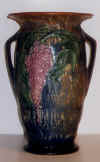 The
Wisteria line, produced in the 1930s, is highly valuable today.
This 12 inch blue model could sell for $2,000 or more in mint condition. The
Wisteria line, produced in the 1930s, is highly valuable today.
This 12 inch blue model could sell for $2,000 or more in mint condition. |
 The
backside (with incised instructions for coloring) of the Freesia
experimental (left) and the smaller Firethorn experimental. The
latter was purchased at a Wisconsin flea market for $35 a few years ago,
and its Baneda style glaze hints at a 1930s origin. The Freesia
line was produced by Roseville in 1945; the Firethorn line was
never produced The
backside (with incised instructions for coloring) of the Freesia
experimental (left) and the smaller Firethorn experimental. The
latter was purchased at a Wisconsin flea market for $35 a few years ago,
and its Baneda style glaze hints at a 1930s origin. The Freesia
line was produced by Roseville in 1945; the Firethorn line was
never produced |
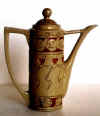 An
elegant, carved Della Robbia teapot, ca. 1906. Some collectors
consider Della Robbia to be Roseville’s greatest line. An
elegant, carved Della Robbia teapot, ca. 1906. Some collectors
consider Della Robbia to be Roseville’s greatest line. |
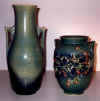 The
backside (with incised instructions for coloring) of the Arrowhead
experimental (left) and the smaller Firethorn experimental. Neither
line was put into production. The
backside (with incised instructions for coloring) of the Arrowhead
experimental (left) and the smaller Firethorn experimental. Neither
line was put into production. |
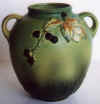 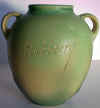 The
Blackberry experimental. The
Blackberry experimental. |
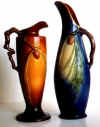 A
sleek Pine Cone "400 series" ewer from the late 1940s or early
1950s, and the smaller, older model designed in the 1930s. A
sleek Pine Cone "400 series" ewer from the late 1940s or early
1950s, and the smaller, older model designed in the 1930s. |
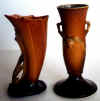 A
"400 series" Pine Cone bud vase designed late in
Roseville’s history on the left, and an older model bud vase, designed
in the 1930s, but also in production in the early 1950s with a new
"400 series" number. A
"400 series" Pine Cone bud vase designed late in
Roseville’s history on the left, and an older model bud vase, designed
in the 1930s, but also in production in the early 1950s with a new
"400 series" number. |
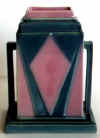 Roseville
Futura model #386-8, known as the Jukebox to collectors. Designed
in the 1920s in the Art Deco style and colors of pink and gray. Roseville
Futura model #386-8, known as the Jukebox to collectors. Designed
in the 1920s in the Art Deco style and colors of pink and gray. |
 Two
valuable Roseville vases from the 1920s which had paper stickers, and
which may appear today with no mark. The smaller is from the Futura
line and the larger is from the Imperial II line. Two
valuable Roseville vases from the 1920s which had paper stickers, and
which may appear today with no mark. The smaller is from the Futura
line and the larger is from the Imperial II line. |
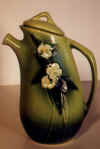 Coffeepot
from the Mock Orange line, first produced in 1950, typical of
Roseville’s late production style. Coffeepot
from the Mock Orange line, first produced in 1950, typical of
Roseville’s late production style. |